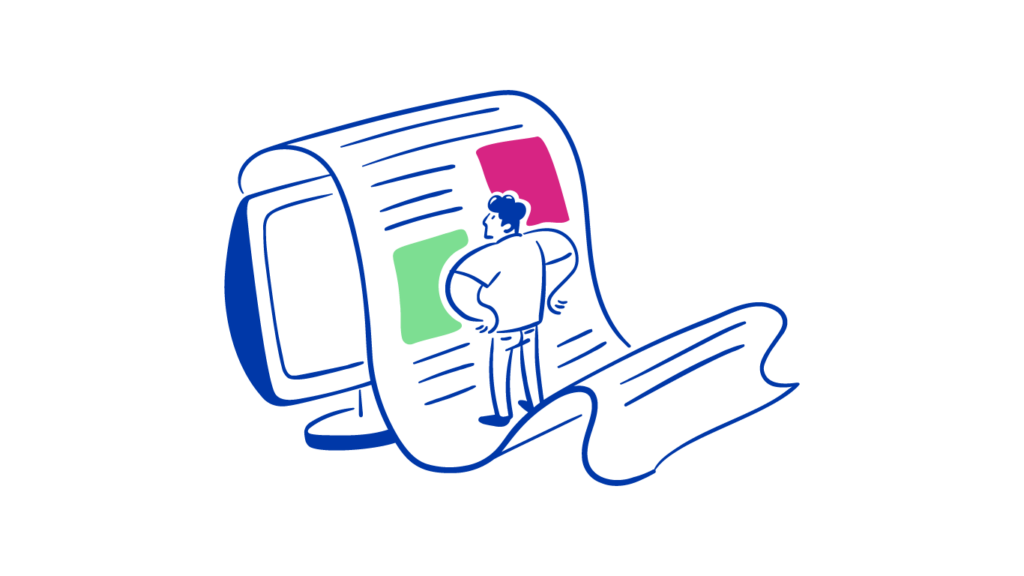The 10 Best Cold Email Examples For Sales Reps

The very first thing you need to get through to your prospects is opening a line of communication. Cold emails have proven to be an effective means of reaching out to your ideal customers. Adding them to your outreach strategy is not straightforward, but it is instrumental if you want to be a successful inside sales rep.
Cold emails are often a double-edged sword. Although they serve the purpose of advertising your product, frequent, annoying emails can do more harm than good for your business. They could, for example, clog your sales pipeline with unsuitable prospects, lowering your sales team’s performance on the way.
This article highlights the best cold email examples to help you navigate this handy, though often misused, sales technique.
The anatomy of a successful cold email
A cold email is an unsolicited way of reaching out to a customer who has no prior relationship with you or your company. You may be worried that it’ll end up in the spam folders, and rightly so, but if you implement the right cold email strategy, it can open up a lot of doors for your business. After all, you’re only asking for a minute of the time where they already spend most of their office hours — in their inbox.
Being concise is critical for a cold email to succeed. It’s vital to be able to grasp the reader’s attention and guarantee yourself a reply. For that, you should bear in mind the following key elements that make up a successful cold email.
1. Have a clear, compelling subject line

The subject line is your hook that can make or break a cold email. You want your prospects to open the mail instead of just sending it to their spam folder. So, it should get the prospect interested without sounding salesy. Remember, you’re trying to make a genuine connection.
A good subject line reflects the content inside but doesn’t give too much away. One example of this might be ‘John, are you outsourcing your application development?’. This subject line includes the prospect’s first name, which adds a touch of personalisation. It also makes them curious about what you have to say. Is there something they should know about outsourcing software development? They’ll want to open the email and find out.
2. Keep the recipient in mind, not your offer
While you’re crafting the email body, it’s important to put your prospect first. Your product should not be the highlight. Start with an appropriate greeting and then include a personalised opener. For example, ‘I read your recent LinkedIn post, and I want to congratulate you on opening a new office in Italy.’ This tells the prospect that you’ve done your research and are familiar with the business.
3. Don’t beat around the bush
After writing a good opener, you’ll want to keep the prospect’s valuable time in mind. Get straight to the purpose of your email and address the prospect’s main pain point. For example, ‘Growing your business means that you’ll need qualified staff, but we all know the right people are hard to find.’
You could also switch up the tone and ask for advice from the prospect. This puts them in an authoritative position, and they’re more likely to respond.
4. Offer a solution

Now it’s time to pitch your solution to help with the prospect’s pain point. For example, ‘I’m wondering if you’re interested in outsourcing application development. [Your product/service] recently helped [company] to create a set of mobile apps while speeding up their process and cutting their costs by 20%.’ You can also include power words like ‘smarter/faster/unique’ to get them interested.
There is one important thing to note here. Some cold emails are primarily intended to get your foot in the door, not to make a sale. These are usually value-providing outreach emails that help you build a foundation with your prospects. So, you could stop at step 3. You can simply reach out by congratulating them on their success or pointing out how their recent post helped you get out of a rut.
5. Add a CTA, but don’t make it salesy
A call-to-action is a piece of text intended to get your prospect to act. It could be making a call, setting up a meeting or simply asking for feedback. It’s important to be mindful of the prospect’s time and not ask for too much.
For example, ‘Can we set up a 30-minute meeting to discuss this?’ sounds too demanding. You’re likely to be turned down. On the other hand, a simple ‘Can you spare a few minutes for a quick chat?’ doesn’t ask a lot from your prospect.
The 10 best cold email examples for sales reps
Let’s take a close look at some of the best cold email examples that have proven to be successful in different industries, including technology, finance and healthcare.
1. Quick Question
The quick question cold email is a great way to up your reply rate. You aren’t pitching anything to them or asking for a lot of their time. For example,
‘Hey, Sandra,
I just wanted to know if your company outsources copywriting.’
This question requires a simple yes or no response, so you’re likely to get one. Once the prospect lets you know, you can write a follow-up email to thank them and then pitch your product/service.
2. AIDA
The AIDA cold email represents the four stages customers go through before buying:
- Attention: Grab your reader’s attention with a catchy subject line and opener.
- Interest: Talk about their pain point or something you know about the prospect’s business that will get them to read the rest of the email.
- Desire: Highlight how your product can help them overcome their pain point.
- Action: Add a CTA to help you seal the deal.
Here’s a cold email example of AIDA at play:
‘Hi, Farrah,
I’m Tamra from [your company name]. What if I told you that our platform can help you reach your target audience?
In the past 3 years, we’ve helped companies like [company names] maximise their engagement potential after implementing [your product name].
We’ve enabled them to put forth a concrete engagement plan, discern industry trends, and improve satisfaction from 50% to 80%. (throw in statistics to get the wheels rolling).
I would love to get in touch with you about how [your product name] can help your company. Will you have a few minutes this week to talk?’
3. Third-Party Connection
This type of cold email is a great way to employ a successful sales technique – getting in touch with hard-to-reach prospects by communicating with low-level employees. Below is an example.
‘Hi, Mark,
I came across your name from [source] (establish a mutual connection), and I’m curious to know if you can be helpful. I’m the [your position] at [your company name] and we have a solution to [prospect’s pain point]. I was wondering if you could let me know of the right person to discuss this with.’
This puts the recipient in a position of responsibility to convey the message to the higher-ups.
4. PAS
PAS is the “Problem, Agitate, and Solve” technique to write a compelling cold email. It’s a three-part formula:
- Problem: Address the prospect’s pain point.
- Agitate: Try to connect with them on an emotional level by expressing how this problem can be so exasperating to deal with.
- Solve: Present them with a solution to the problem by pitching your product.
Here’s an example.
‘Hi, Seth,
I’ve noticed that [prospect’s company name] is facing some trouble with the shift to a new CRM software.
It can be really frustrating when this problem interferes with efficiency and lays valuable resources to waste.
Our company, [company name], offers training services to help employees reach their full potential.
Maybe you’d like to hear more about it over a quick chat?’
5. Straight to Business
Sometimes, the most effective approach is to be direct. The ‘straight to business’ cold email is useful when you’re reaching out to busy professionals. Here’s an example,
‘Hi, Peter,
This is Pritchett from [your company name]. I’ve noticed that your company is experiencing [pain point] and would benefit from an upgrade.
Our medical devices have helped companies like yours to improve medical results, regulate costs and ensure staff satisfaction.
Do you have a few minutes to spare this week for a call?’
6. Paint a picture
The ‘paint a picture’ cold email is a fast way to induce a response by using the power of imagination. Paint a picture for your prospect of how your product can help them achieve the efficiency they desire. For example,
‘Hi, Clark,
Managing overhead costs can indeed be very daunting, especially in large-scale companies like yours.
Imagine an atmosphere where you don’t have to worry about overseeing every employee to ensure compliance.
With [your product name], that can be a reality.
Let me know if you’re available sometime this week for a quick chat.’
7. Something useful
Who doesn’t love being given something valuable without having to offer anything in return? The ‘something useful’ cold email is a way to establish a rapport with your prospect. Do some research via social media and find a way to connect with them. Here’s an example.
‘Hi, Henry,
I recently came across a post of yours about [post topic] and I found it incredibly insightful.
[Elaborate what you liked about the post and your main takeaway from it]
Have you taken a look at [blog] by [name] that opens up this topic further?’
8. But you are free
This cold email template is a great way to get a response by providing your prospects with a way out. Here’s an example to illustrate this.
‘Hi, Gary,
I’m Stefan, a sales rep from [your company name]. I was wondering if you’re interested in optimising your website content.
We’re a startup company that helps corporations reach their target audience and overcome language barriers. We believe [prospect’s company] could benefit from our offerings.
If you’re not interested, it’s understandable. Thank you for your time!’
9. Star-Chain-Hook
This three-part formula is designed to first draw your prospect’s attention (star), fascinate them with some facts and stats (chain) and then reel them in with a CTA (hook). Let’s look at a working example.
‘Hi, Helen,
This is Greg from [your company name].
[name of the company you’ve helped] has been saving valuable work hours by implementing this simple tool.
We’ve been able to help our clientele free up a fourth of their time with [your product/service]. This tool helps automate scheduling, payroll, employee tracking, and more.
If you’re interested, consider signing up for our 30-day trial period here [add a CTA button].’
10. Star-Story-Solution
The “Star Story Solution” is another great three-part formula for a cold email campaign to increase conversion rates. It includes a star (it could be your company or someone else), their story about a common pain point and how the star was able to overcome all odds using your solution. For example:
‘Hi, Kent,
Three years ago, [your company name] was facing negative customer reviews. We were losing customers left and right because of a lack of organization and proper tools.
Today, we’re able to reach millions of people around the globe.
We have successfully morphed the negative reviews into loyal consumers. [Your product name] is our secret.
We believe we can help your company turn everything around as we did.
If you’re interested in taking this further, let me know.’
Tips for personalising cold emails
Here are a few tips to help you personalise your cold emails and not make them sound like spam or like they were sent in bulk:
- Use the recipient’s name in the email.
- Mention the company’s name and its industry.
- Research the company’s history and activities in the industry to discern pain points.
- Tailor the message to those specific pain points and offer a solution they genuinely need.
- Talk about a recent post they wrote on social media.
- Highlight the prospective company’s technologies.
FAQs
When should you send a cold email?
Timing is very important when it comes to cold emails. Studies have shown that the best time to send a cold email is around 8 to 9 am on weekdays. You don’t want to send it when your prospects aren’t at their work desk.
Is cold email spam?
Here are the key differences between cold emails and spam:
| Cold Email | Spam |
| Includes personalised content | Includes irrelevant content |
| Prospect-specific message | One templated message that’s sent in bulk |
| Adds value to the prospect without incorporating a salesy tone | Written just to sell |
| Involves prior research on the recipient | Doesn’t involve any research |
Are there laws against cold emailing?
Cold emailing isn’t illegal, but depending on your country, you might need to conform to anti-spam laws. These include GDPR and the CAN-SPAM Act, for example.
Conclusion
Cold email campaigns are a great way to build rapport with your potential customers. As a sales rep, we hope you’re able to look at cold emailing as a valuable opportunity. It’s easy to get marked off as spam if you don’t employ the right technique. After viewing some of our best cold email examples, we hope you understand how to navigate these tricky waters better.
References and Further Reading
- How To Be A Successful Inside Sales Representative And Crush It
- How to Dramatically Improve Your Sales Pipeline + Examples
- The Essential Sales Team Performance Metrics To Track
- Cold Email Strategy Guide: The 10-Step Method for Outreach That Works
- How to Follow Up with a Sales Lead Like a Pro
- Cold Email Marketing: 6 Tips for Campaigns That Get Read
- Seven Proactive Sales Techniques to Scale Your Sales Now
- The Best Time to Send an Email (What 9 Studies Say)
- A Guide to Cold Emailing
- Proactive Sales Techniques To Help You Scale